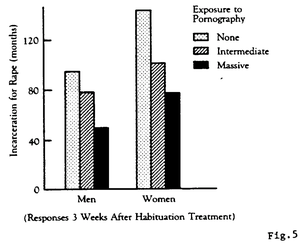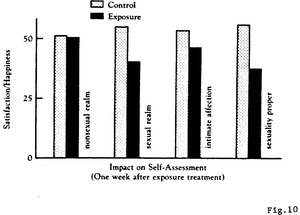This is an old revision of this page, as edited by John254 (talk | contribs) at 04:28, 10 February 2008 (Of course, not all epidemiological studies claim that pornography is good wholesome fun :)). The present address (URL) is a permanent link to this revision, which may differ significantly from the current revision.
Revision as of 04:28, 10 February 2008 by John254 (talk | contribs) (Of course, not all epidemiological studies claim that pornography is good wholesome fun :))(diff) ← Previous revision | Latest revision (diff) | Newer revision → (diff)Research concerning the public health effects of pornography is inconclusive, with some studies supporting the contention that the viewing of pornographic material may increase rates of sexual assault, while others have shown no effects, or a decrease in the rates of such crimes.
Epidemiological studies
An epidemiological study describes the association between given behaviors or environmental conditions, and physical or psychological health by means of observation of real-world phenomena through statistical data. Epidemiological studies generally have high levels of external validity, insofar as they accurately describe events as they occur outside of a laboratory setting, but low levels of internal validity, since they do not strongly establish cause-and-effect relationships between the behaviors or conditions under study, and the health consequences observed.
"The effects of Pornography: An International Perspective" was an epidemiological study which found that the massive growth of the pornography industry in the United States between 1975 and 1995 was accompanied by a substantial decrease in the number of sexual assaults per capita; and reported similar results for Japan. Findings of this nature have been critiqued by Robert Peters, president of Morality in Media, on the grounds that the results are better explained by factors other than the increased prevalence of pornography:
a more plausible explanation is that if there is a decline in “forcible rape,” it is the result of a tremendous effort to curb rape through community and school-based programs, media coverage, aggressive law enforcement, DNA evidence, longer prison sentences, and more.
Furthermore, a review of epidemiological studies found that the quantity of pornographic material viewed by men was positively correlated with degree to which they endorsed sexual assault.
Controlled studies



In this context, a controlled study describes the correlation between given behaviors or environmental conditions and health effects in a laboratory setting in which conditions other than those under study are effectively held constant across groups of participants receiving various levels of the experimental condition(s). Since it is considered that the only functional difference between groups is the level of experimental condition(s) received, researchers can strongly infer cause-and-effect relationships from statistically significant associations between experimental condition(s) and health consequences. Thus, controlled studies have high levels of internal validity. However, such studies often suffer from questionable external validity due to the considerable differences between real-world environments and laboratory settings, and the consequent belief that results cannot be generalized beyond the experimental context. A double-blind study involves participants who are unaware of the levels of experimental condition(s) that they are receiving, and recording of data by observers who are likewise not informed of the groups to which participants have been assigned. Double-blind studies avoid biased results due to participants' or observers' beliefs concerning the effects of the experimental condition(s). While often performed to assess the effects of pharmaceuticals, since placebo medication can be employed, double-blind studies concerning the health consequences of viewing pornographic materials are impossible, as participants would be aware of their exposure to the experimental condition.
"Effects of Prolonged Consumption of Pornography" was review of controlled studies which found that extensive viewing of the type of pornographic material commonly sold at adult bookstores was positively correlated with leniency in the sentencing of a person convicted of rape in a mock trial setting (figure 5), decreased satisfaction of participants with their sex lives and partners (figure 10), and an increased self-reported willingness to commit rape or other forced sexual acts (figure 12). This line of research has been critiqued in "The effects of Pornography: An International Perspective" on external validity grounds:
Lab experiments typically do not take into account context and other crucial social and situational factors in considering the audience or the material... In real life, individuals are free to satisfy different sexual urges in ways unavailable to students in classroom or subjects in laboratory situations.
References:
- ^ The effects of Pornography: An International Perspective
- Malamuth, Neil M.: "Do Sexually Violent Media Indirectly Contribute to Antisocial Behavior?", , page 10
- Zillmann, Dolf: "Effects of Prolonged Consumption of Pornography",
Report of the Surgeon General's Workshop on Pornography and Public Health, United States Public Health Service, Office of the Surgeon General, August 4, 1986